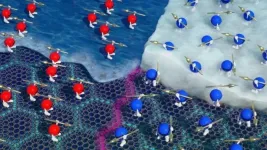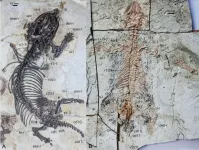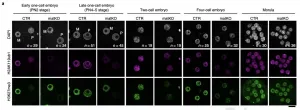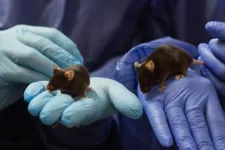INFORMATION:
Prof. Shahal Ilani's research is supported by the Sagol Weizmann-MIT Bridge Program; the André Deloro Prize for Scientific Research; the Rosa and Emilio Segre Research Award; and the Leona M. and Harry B. Helmsley Charitable Trust.
Prof. Erez Berg's research is supported by Irving and Cherna Moskowitz.
Prof. Yuval Oreg's research is supported by the Lady Davis Professorial Chair of Experimental Physics. Prof. Oreg is the Head of the Maurice and Gabriella Goldschleger Center for Nanophysics.
Prof. Ady Stern's research is supported by the Veronika A. Rabl Physics Discretionary Fund and the Zuckerman STEM Leadership Program.
Entropy measurements reveal exotic effect in "magic-angle" graphene
Researchers at the Weizmann Institute of Science and the Massachusetts Institute of Technology discover a surprising phase transition in twisted bilayer graphene
2021-04-07
(Press-News.org) Most materials go from being solids to liquids when they are heated. One rare counter-example is helium-3, which can solidify upon heating. This counterintuitive and exotic effect, known as the Pomeranchuk effect, may now have found its electronic analogue in a material known as magic-angle graphene, says a team of researchers from the Weizmann Institute of Science led by Prof. Shahal Ilani, in collaboration with Prof. Pablo Jarillo-Herrero's group at the Massachusetts Institute of Technology (MIT).
This result, published today in Nature, comes thanks to the first ever measurement of electronic entropy in an atomically-thin two dimensional material. "Entropy describes the level of disorder in a material and determines which of its phases is stable at different temperatures," explains Ilani. "Our team set up to measure the electronic entropy in magic angle graphene to resolve some of its outstanding mysteries, but discovered another surprise".
Giant magnetic entropy
Entropy is a basic physical quantities that is not easy to grasp or measure directly. At low temperatures, most of the degrees of freedom in a conducting material freeze out, and only the electrons contribute to the entropy. In bulk materials, there is an abundance of electrons, and thus it is possible to measure their heat capacity and from that deduce the entropy. In an atomically-thin two-dimensional material, due to the small number of electrons, such a measurement becomes extremely challenging. So far, no experiments succeeded in measuring the entropy in such systems.
To measure the entropy, the Weizmann team used a unique scanning microscope comprising of a carbon nanotube single-electron transistor positioned at the edge of a scanning probe cantilever. This instrument can spatially image the electrostatic potential produced by electrons in a material, with an unprecedented sensitivity. Based on Maxwell's relations that connect the different thermodynamic properties of a material, one can use these electrostatic measurements to directly probe the entropy of the electrons.
"When we performed the measurements at high magnetic fields, the entropy looked absolutely normal, following the expected behaviour of a conventional (Fermi) liquid of electrons, which is the most standard state in which electrons exist at low temperatures. Surprisingly, however, at zero magnetic field, the electrons exhibited giant excess entropy, whose presence was very mysterious." says Ilani. This giant entropy emerged when the number of electrons in the system was about one per each site of the artificial "superlattice" formed in magic angle graphene.
Artificial "superlattice" in twisted layers of graphene
Graphene is a one atom thick crystal of carbon atoms arranged in a hexagonal lattice. When two graphene sheets are placed on top of each other with a small and special, or "magic", misalignment angle, a periodic moiré pattern appears that acts as an artificial "superlattice" for the electrons in the material. Moiré patterns are a popular effect in fabrics and emerge wherever one mesh overlays another at a slight angle.
In magic angle graphene, the electrons come in four flavours: spin "up" or spin "down", and two "valleys". Each moiré site can thus hold up to four electrons, one of each flavour.
Researchers already knew that this system behaves as a simple insulator when all moiré sites are completely full (four electrons per site). In 2018, however, Prof. Jarillo-Herrero and colleagues discovered to their surprise that it can be insulating at other integer fillings (two or three electrons per moiré site), which could only be explained if a correlated state of electrons is formed. However, near a filling of one electron per moiré site, the vast majority of transport measurements indicated that the system is quite simple, behaving as an ordinary metal. This is exactly where the entropy measurements by the Weizmann-MIT team found the most surprising results.
"In contrast to the behaviour seen in transport near a filling of one electron per moiré site, which is quite featureless, our measurements indicated that thermodynamically, the most dramatic phase transition occurs at this filling", says Dr. Asaf Rozen, a lead author in this work. "We realized that near this filling, upon heating the material, a rather conventional Fermi liquid transforms into a correlated metal with a giant magnetic entropy. This giant entropy (of about 1 Boltzmann constant per lattice site) could only be explained if each moiré site has a degree of freedom that is completely free to fluctuate".
An electronic analogue of the Pomeranchuk effect
"This unusual excess entropy reminded us of an exotic effect that was discovered about 70 years ago in helium-3", says Weizmann theorist Prof. Erez Berg. "Most materials, when heated up, transform from a solid to a liquid. This is because a liquid always has more entropy than the solid, as the atoms move more erratically in the liquid than in the solid." In helium-3, however, in a small part of the phase diagram, the material behaves completely oppositely, and the higher temperature phase is the solid. This behaviour, predicted by Soviet theoretical physicist Isaak Pomeranchuk in the 1950s, can only be explained by the existence of another "hidden" source of entropy in the system. In the case of helium-3, this entropy comes from the freely rotating nuclear spins. "Each atom has a spin in its nucleus (an 'arrow' that can point in any direction)," explains Berg. "In liquid helium-3, due to the Pauli exclusion principle, exactly half of the spins must point up and half must point down, so spins cannot freely rotate. In the solid phase, however, the atoms are localized and never come close to each other, so their nuclear spins can freely rotate."
"The giant excess entropy that we observed in the correlated state with one electron per moiré site is analogous to the entropy in solid helium-3, but instead of atoms and nuclear spins, in the case of magic angle graphene we have electrons and electronic spins (or valley magnetic moments)", he says.
The magnetic phase diagram
To establish the relation with the Pomeranchuk effect further, the team performed detailed measurements of the phase diagram. This was done by measuring the "compressibility" of the electrons in the system- that is, how hard it is to squeeze additional electrons into a given lattice site (such a measurement was demonstrated in twisted bilayer graphene in the team's previous work). This measurement revealed two distinct phases separated by a sharp drop in the compressibility: a low-entropy, electronic liquid-like phase, and a high-entropy solid-like phase with free magnetic moments. By following the drop in the compressibility, the researchers mapped the boundary between the two phases as a function of temperature and magnetic field, demonstrating that the phase boundary behaves precisely as expected from the Pomerachuk effect.
"This new result challenges our understanding of magic angle graphene," says Berg. "We imagined that the phases in this material were simple - either conducting or insulating, and expected that at such low temperatures, all the electronic fluctuations are frozen out. This turns out not to be the case, as the giant magnetic entropy shows".
"The new findings will provide fresh insights into the physics of strongly correlated electron systems and perhaps even help explain how such fluctuating spins affect superconductivity," he adds.
The researchers acknowledge that they do not yet know how to explain the Pomeranchuk effect in magic angle graphene. Is it exactly as in helium-3 in that the electrons in the solid-like phase remain at a great distance from each other, allowing their magnetic moments to stay completely free? "We are not sure," admits Ilani, "since the phase we have observed has a 'spit personality' - some of its properties are associated with itinerant electrons while others can only be explained by thinking of the electrons as being localized on a lattice".
ELSE PRESS RELEASES FROM THIS DATE:
New Lyme disease test distinguishes between early and late-stage disease
2021-04-07
For those who live in an area blighted by ticks, the threat of Lyme disease can cast a shadow over the joy of spring and summer. These blood-sucking arachnids can transmit bacteria into the bloodstream of their unsuspecting host, causing the disease. Early treatment is essential, but current tests are not usually sensitive enough to detect the disease in early-stage patients. A recent study in open-access journal END ...
Scientists discover two new species of ancient, burrowing mammal ancestors
2021-04-07
A joint research team led by Dr. MAO Fangyuan and Dr. ZHANG Chi from the Institute of Vertebrate Paleontology and Paleoanthropology (IVPP) of the Chinese Academy of Sciences and Prof. MENG Jin from the American Museum of Natural History have discovered two new species of mammal-like, burrowing animals that lived about 120 million years ago in what is now northeastern China.
The new species, described in Nature on April 7, are distantly related. However, they independently evolved traits to support their digging lifestyle. They represent the first "scratch diggers" discovered in this ecosystem.
"There are many hypotheses about why animals dig into the soil and live underground," said Prof. MENG, lead author of the study. "For protection against predators, ...
Study finds late night snacks may hurt your workplace performance
2021-04-07
A recent study finds that unhealthy eating behaviors at night can make people less helpful and more withdrawn the next day at work.
"For the first time, we have shown that healthy eating immediately affects our workplace behaviors and performance," says Seonghee "Sophia" Cho, corresponding author of the study and an assistant professor of psychology at North Carolina State University. "It is relatively well established that other health-related behaviors, such as sleep and exercise, affect our work. But nobody had looked at the short-term effects of unhealthy eating."
Fundamentally, the researchers had two questions: Does unhealthy eating behavior affect you at work the next day? And, if so, why?
For the study, ...
Inheriting acquired traits requires trailblazer modifications to unfertilized eggs
2021-04-07
An epigenetic study at the RIKEN Center for Integrative Medical Sciences shows that in mouse egg cells, modifications to histone H2A at lysine 119 lay the groundwork for inherited DNA functional modifications from the mother.
In books and the movies, a group of people on a special mission always sends out a scout to do reconnaissance before they proceed. Sometimes, the scouts leave signs or markers that allow the group to know where there should go. Researchers led by Azusa Inoue at the RIKEN Center for Integrative Medical Sciences in Japan have discovered a mark left behind in unfertilized egg cells that determine which DNA modifications ...
A new mouse model gave surprising findings about Folling Disease
2021-04-07
In Norway, all newborn children are tested for 25 rare genetic diseases through the Newborn Screening program, and the most common of these is phenylketonuria (abbreviated to PKU), known as Folling Disease.
Every year, between 3-7 children are born in Norway with PKU, and this diagnosis has a great impact on the rest of their lives. People with PKU must follow a very strict diet all their lives, where they must avoid almost all foods that contain proteins.
"Failure to implement the diet from birth may result in irreversible physical problems and brain damage, and optimal brain function requires life-long adherence", explains Professor ...
UMD tracks the adoption of green infrastructure, from water conservation to policy
2021-04-07
In a new paper published in the Journal of Environmental Policy & Planning, the University of Maryland teamed up with local researchers to examine green infrastructure adoption and leadership in Tucson, Arizona, an interesting case study where grassroots efforts have helped to drive policy change in a growing urban area surrounded by water-constrained desert. Green infrastructure (any installation that manages water or environmental factors, such as rain gardens, stormwater basins, or urban tree cover) is slowly transitioning from a fringe activity to an important part of the way governments and municipalities are dealing with water and the local effects of a changing climate. By examining ...
Study revises understanding of cancer metabolism
2021-04-07
Tumors consume glucose at high rates, but a team of Vanderbilt researchers has discovered that cancer cells themselves are not the culprit, upending models of cancer metabolism that have been developed and refined over the last 100 years.
Instead, non-cancer cells in a tumor -- primarily immune cells called macrophages -- have the highest glucose uptake, the group reported April 7 in the journal Nature. The findings that different cells in the tumor microenvironment use distinct nutrients according to their own metabolic programs could be exploited to develop new therapies and imaging strategies, ...
Early indicators of magma viscosity could help forecast a volcano's eruption style
2021-04-07
Washington, DC-- The 2018 eruption of Kīlauea Volcano in Hawai'i provided scientists with an unprecedented opportunity to identify new factors that could help forecast the hazard potential of future eruptions.
The properties of the magma inside a volcano affect how an eruption will play out. In particular, the viscosity of this molten rock is a major factor in influencing how hazardous an eruption could be for nearby communities.
Very viscous magmas are linked with more powerful explosions because they can block gas from escaping through vents, allowing pressure ...
Childhood cognitive problems could lead to mental health issues in later life
2021-04-07
Children experiencing cognitive problems such as low attention, poor memory or lack of inhibition may later suffer mental health issues as teenagers and young adults, a new study reveals.
Targeting specific markers in childhood for early treatment may help to minimise the risk of children developing certain psychopathological problems in adolescence and adult life, such as borderline personality disorder, depression and psychosis.
Cognitive deficits are core features of mental disorders and important in predicting long-term prognosis - the researchers' work indicates that individual patterns of such deficits predate ...
Ocular assessments of newborns gestationally exposed to maternal COVID-19 infection
2021-04-07
What The Study Did: This case series examines whether maternal SARS-CoV-2 is associated with outcomes in the eyes of their newborns.
Authors: Olívia Pereira Kiappe, M.D., M.Sc., of Universidade Federal de São Paulo in Brazil, is the corresponding author.
To access the embargoed study: Visit our For The Media website at this link https://media.jamanetwork.com/
(doi:10.1001/jamaophthalmol.2021.1088)
Editor's Note: Please see the article for additional information, including other authors, author contributions and affiliations, conflict of interest and financial disclosures, ...
LAST 30 PRESS RELEASES:
Tracing the quick synthesis of an industrially important catalyst
New software sheds light on cancer’s hidden genetic networks
UT Health San Antonio awarded $3 million in CPRIT grants to bolster cancer research and prevention efforts in South Texas
Third symposium spotlights global challenge of new contaminants in China’s fight against pollution
From straw to soil harmony: International team reveals how biochar supercharges carbon-smart farming
Myeloma: How AI is redrawing the map of cancer care
Manhattan E. Charurat, Ph.D., MHS invested as the Homer and Martha Gudelsky Distinguished Professor in Medicine at the University of Maryland School of Medicine
Insilico Medicine’s Pharma.AI Q4 Winter Launch Recap: Revolutionizing drug discovery with cutting-edge AI innovations, accelerating the path to pharmaceutical superintelligence
Nanoplastics have diet-dependent impacts on digestive system health
Brain neuron death occurs throughout life and increases with age, a natural human protein drug may halt neuron death in Alzheimer’s disease
SPIE and CLP announce the recipients of the 2025 Advanced Photonics Young Innovator Award
Lessons from the Caldor Fire’s Christmas Valley ‘Miracle’
Ant societies rose by trading individual protection for collective power
Research reveals how ancient viral DNA shapes early embryonic development
A molecular gatekeeper that controls protein synthesis
New ‘cloaking device’ concept to shield sensitive tech from magnetic fields
Researchers show impact of mountain building and climate change on alpine biodiversity
Study models the transition from Neanderthals to modern humans in Europe
University of Phoenix College of Doctoral Studies releases white paper on AI-driven skilling to reduce burnout and restore worker autonomy
AIs fail at the game of visual “telephone”
The levers for a sustainable food system
Potential changes in US homelessness by ending federal support for housing first programs
Vulnerability of large language models to prompt injection when providing medical advice
Researchers develop new system for high-energy-density, long-life, multi-electron transfer bromine-based flow batteries
Ending federal support for housing first programs could increase U.S. homelessness by 5% in one year, new JAMA study finds
New research uncovers molecular ‘safety switch’ shielding cancers from immune attack
Bacteria resisting viral infection can still sink carbon to ocean floor
Younger biological age may increase depression risk in older women during COVID-19
Bharat Innovates 2026 National Basecamp Showcases India’s Most Promising Deep-Tech Ventures
Here’s what determines whether your income level rises or falls
[Press-News.org] Entropy measurements reveal exotic effect in "magic-angle" grapheneResearchers at the Weizmann Institute of Science and the Massachusetts Institute of Technology discover a surprising phase transition in twisted bilayer graphene





